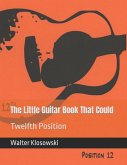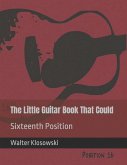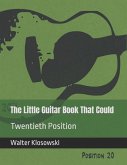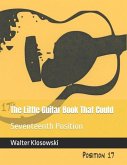This LITTLE GUITAR BOOK THAT COULD showcases the C A G E D guitar chord and scale sequence exclusively in the ELEVENTH POSITION, for all to see, use and reference. But, before thumbing through this book, there's some material that the guitarist may need reminding of...even though he or she may have played for years. For example, in this book, six is the exact number of consecutive frets involved in this, the ELEVENTH POSITION, and it spans a full two octaves plus a perfect fourth when in standard tuning. Plus when in this position the second and third fingers on the fretting hand are to remain stationary in their respective frets or "slots", initially, as their stationary qualities allow the first and or fourth finger to stretch or slide that additional space. For the picking hand though, a very important pattern occurs down by the sound hole or bridge; this pattern involving every other string. Such is best evidenced when the C A G E D main root note sequence is plucked alphabetically, starting with the E root on the first or thinnest guitar string. To discover it, start by picking the E there (first string, third finger); then G (third string, third finger); A (fifth string, third finger); C (second string, fourth finger); D (fourth string, third finger) and conclude with the E (sixth string, third finger). This first-third-fifth-second-fourth-sixth string pattern naturally fits the picking hand and is looped, forwards or backwards (six-four-two-five-three-one) as the E roots on the first /sixth string(s) in the ELEVENTH POSITION are deemed interchangeable. There are also three musical terms that need clarification...those being main root notes, octaves and unisons. What are main root notes? Main root notes represent a specific set of root notes that in general fall or cluster under the second and third fingers of the fretting hand. Once the location of each main root note is learned, the attention then moves to their octaves. An octave is defined as the interval between one musical pitch and another with half or double its own frequency. Some correctly call the interval a "perfect octave", and in guitarland, octaves are usually "one string one fret away". This handy fact helps memorize their location even though, occasionally, two strings and or two frets are involved (the same concept applies in that there will be some sort of string skipping). And lastly, unisons are defined as when two or more notes in music happen to sound the same pitch, and in guitarland, it usually means "same note different string or fret". The term also implies that the unison occurs in the guitar position at hand. So that's it! THE LITTLE GUITAR BOOK THAT COULD for the ELEVENTH POSITION is uncomplicated, straightforward and super easy to use. Its picture worth a thousand words format, being visually based, allows one to take full advantage of the guitar fretboard material right away. You'll have fun discovering some fresh perspectives on the same old same old, while also adding some new twists and turns to your own technique. Plus THE LITTLE GUITAR BOOK THAT COULD for the ELEVENTH POSITION contains generous amounts of manuscript and tablature paper too, akin to a guitar manuscript journal; a very neat feature. In closing, thank you very kindly for choosing to include THE LITTLE GUITAR BOOK THAT COULD in your library of fretboard knowledge needs. Enjoy!








